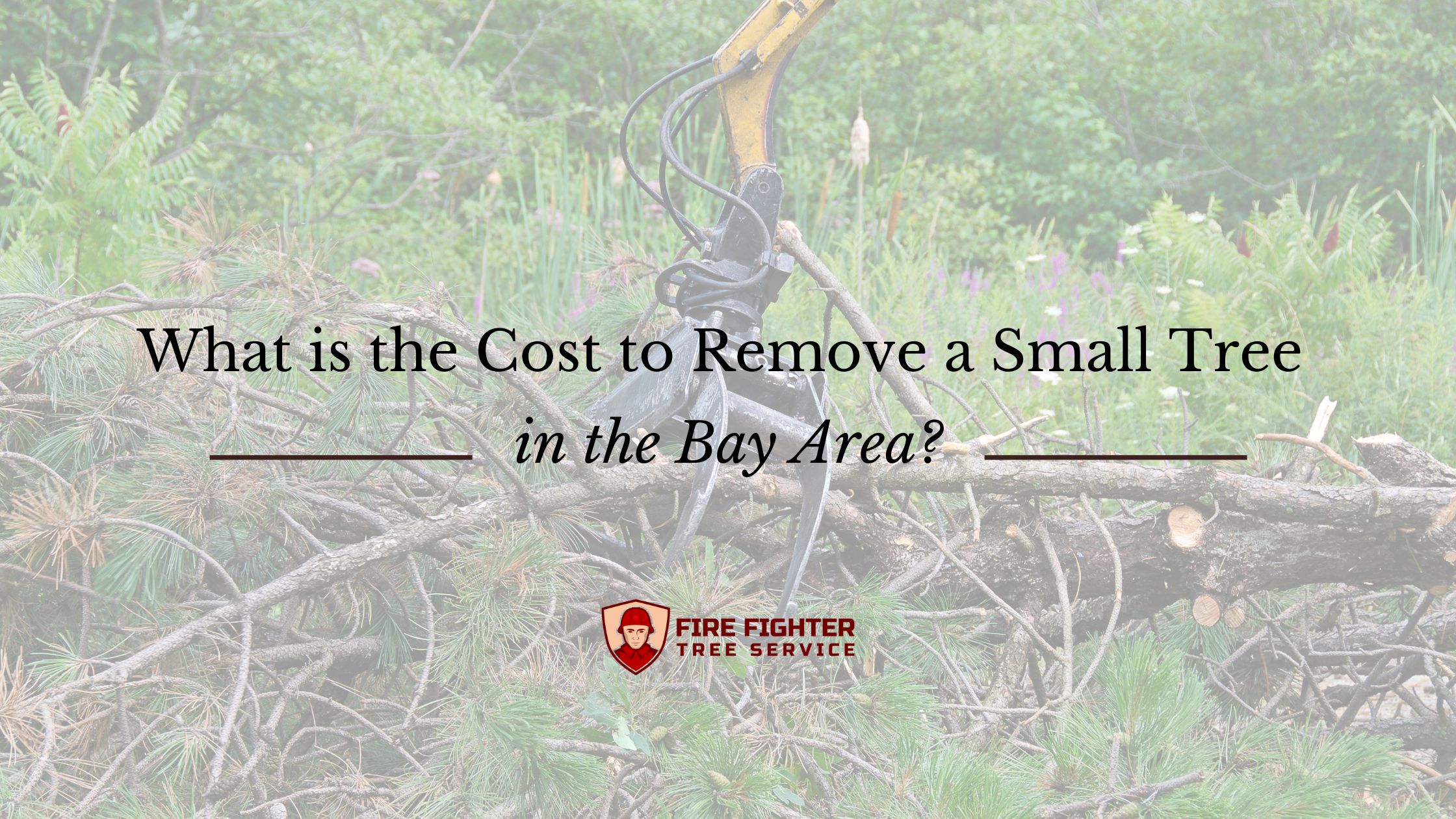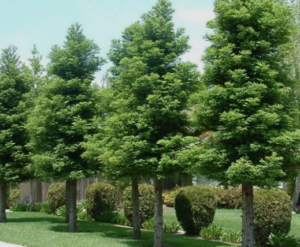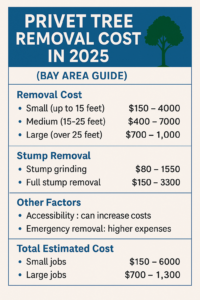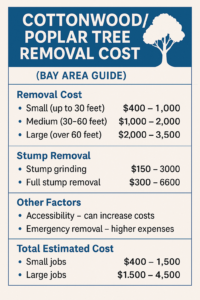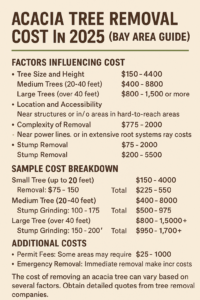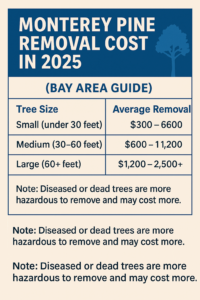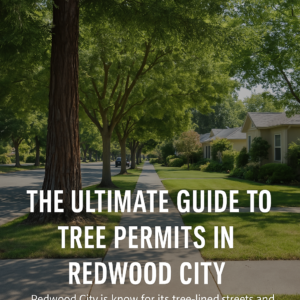Tree removal in the Bay Area, particularly in San Francisco, is an essential aspect of property maintenance for many residents. With the city having transferred the care of more than half of its street trees to residents, searches for the cost to remove a small tree are increasing each day.
In this guide, we will explore the following:
- Factors Influencing Small Tree Removal Cost
- Average Cost of Tree Removal in San Francisco
- Breakdown of Costs
- Additional Services and Their Costs
- San Francisco Tree Facts & FAQs
Factors Influencing Small Tree Removal Cost
Several factors determine the cost of removing a small tree in the Bay Area. They include the tree’s height and circumference, the complexity of the removal process, the time and labor required, and the type and condition of the tree.

1. Tree Height and Circumference
The size of the tree is one of the primary determinants of the removal cost. Generally, smaller trees are less expensive to remove compared to larger ones. For a small tree, the average height is typically less than 30 feet. The tree’s circumference also plays a significant role; removing a thicker trunk may require more effort and time, increasing the cost.
2. Type of Tree
Different types of trees have varying removal costs due to their structural differences and the effort required to remove them. Below are some common small trees in the Bay Area and their estimated removal costs:
| Type of Tree | Estimated Removal Cost |
| Brisbane Box | $500 – $700 |
| New Zealand Christmas Tree | $550 – $750 |
| Sycamore London Plane | $600 – $800 |
| Red Flowering Gum | $600 – $800 |
| Hybrid Strawberry | $450 – $650 |
| Mayten | $500 – $700 |
| Cherry Plum | $500 – $700 |
3. Complexity of Removal
The complexity of the removal process can significantly impact the cost. Trees near power lines, buildings, or other structures may require special equipment and additional labor. As a result, the overall expense increases. Additionally, trees with extensive root systems can be more challenging to remove.
4. Condition of the Tree
The health of the tree also affects the removal cost. Removing a dead or diseased tree can be more complicated and dangerous, requiring specialized equipment and safety measures. Healthy trees are typically easier and less costly to remove.
5. Accessibility
The accessibility of the tree’s location is another factor that can influence the cost. Trees in hard-to-reach areas, such as those surrounded by buildings or other structures, may require more time and effort to remove, increasing the overall cost.
Average Cost of Tree Removal in San Francisco

In San Francisco, the average cost to remove a small tree is around $992. However, this price can vary depending on the factors mentioned above. Typically, the rates range from $832 to $1,152. A certified arborist will usually provide a quote for the job without charging an initial fee.
Breakdown of Costs
- Labor Costs: The time and effort required by the workers are significant components of the overall cost. It includes the time to cut down the tree, remove the branches, and haul away the debris.
- Equipment Costs: Specialized equipment, such as chainsaws, cranes, and wood chippers, adds to the cost. More complex removals may require more advanced machinery.
- Disposal Fees: The cost of disposing of the tree, including any additional charges for hauling away large branches or trunks, is included in the total price.
Additional Services and Their Costs
1. Stump Removal
Stump removal is often required after a tree is cut down. In San Francisco, stump removal costs approximately $200. The process can either involve uprooting the entire stump or grinding it down into wood chips. The latter option is generally less expensive and faster. Below are the typical costs based on the method:
- Stump Grinding: $150 – $250
- Stump Uprooting: $200 – $300
2. Tree Maintenance
Regular maintenance, including trimming, pruning, and cutting, is crucial for the health and aesthetics of your trees. The average cost for tree maintenance in San Francisco is about $637, fluctuating between $526 and $748. Regular maintenance can help prevent larger, more expensive issues in the future.
3. Emergency Tree Removal

Sometimes, a tree can pose an immediate risk due to storm damage or disease, necessitating emergency removal services. Due to the urgency and the need for immediate action, emergency tree removal can be significantly more expensive. Costs can range from $1,000 to $2,500, depending on the complexity and time of the service.
4. Tree Planting
Planting a new tree can also incur costs if you want to replace a removed tree. Depending on the tree type and the sapling’s size, planting costs can range from $150 to $500. It includes the cost of the tree, labor for planting, and any necessary soil amendments or fertilizers.
San Francisco Tree Facts & FAQs
San Francisco is home to a diverse array of trees, many of which are now in residents’ care. Below are some important facts and frequently asked questions about trees in the area.
Do I Need a Permit to Remove a Tree?
You do not require a permit for private property unless the tree is a landmark or near the public right of way. However, removing street trees given over to residents does require a permit. Additionally, these trees have strict pruning regulations, and improper care can result in fines.
When is the Best Time to Remove a Tree?
The optimal time for tree removal in San Francisco is in January when tree growth slows. This time makes it easier to prune and uproot the trees.
What Trees Should Be Avoided?
Some invasive trees, such as Blue Gum Eucalyptus, Monterey Pines, and Monterey Cypress, are difficult to maintain and can overrun the native tree population. It’s best to avoid planting or maintaining these species.
What Common Diseases Affect Trees in San Francisco?
Trees in San Francisco are susceptible to various diseases, such as fire blight, powdery mildew, anthracnose, and short-hole fungus. Regular maintenance and early detection are key to preventing these diseases from spreading.
What are the Rules Regarding Trees and Overhead Power Lines?
Trees must be planted at least 10 feet away from overhead power lines. PG&E, the local utility company, regularly inspects and prunes vegetation around power lines. If you hire tree service professionals, you should ensure the workers are well-versed in electrical safety.
